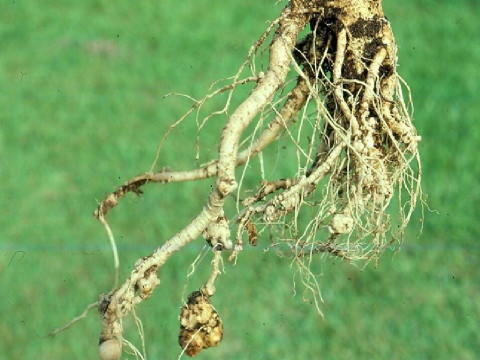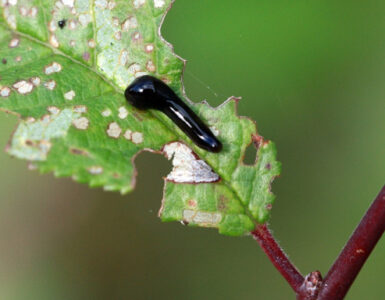Have you noticed small, knotted bumps on the roots of your plants? If so, then you are likely dealing with root-knot nematodes.
So what are they? These pests are worm-like organisms that live in the soil.
They feed on a variety of plant roots and can cause severe damage to crops. They cause plants to become stressed, making it difficult for them to take up water or nutrients [1].
In this article, I’ll share some tips that I’ve picked up on how to control these nematodes organically.
Crops Susceptible to Root-Knot Nematodes
Several types of crops are particularly susceptible to these pests, including:
- Tomatoes
- Lettuce
- Peppers
- Squash
- Carrots
- Okra
- Irish potato
- Eggplant
These soil-borne pests can cause stunted or abnormal root growth, wilting, and even death in severe cases. You may also notice that plants take longer to mature and yield smaller fruits and vegetables.
How to Get Rid of Root-Knot Nematodes Naturally
Below are some effective home remedies and natural methods for controlling root-knot nematodes.
1. Crop Rotation
Rotate your crops. Doing so can be a great way to prevent the buildup of pests and diseases in the soil.
When rotating your crops, make sure they don’t belong to the same family. It’s best to alternate between different plant families.
2. Natural Predators
Introduce beneficial organisms to your garden soil. Doing so may help control plant-parasitic nematodes.
For example, predatory nematodes are organisms that eat other types of harmful nematodes in the garden. Other natural predators include flatworms and mites [2].
3. Soil Solarization
This technique utilizes the sun’s heat to control soil-borne pests, such as root-knot nematodes. It’s basically a form of solar-powered pest control.
It utilizes a tarp-like material to trap solar heat in the soil. This causes the nematodes and insects in the soil to die due to the extreme temperatures.
4. Nematode-Suppressive Plants
Some plants actually have natural nematicides. This makes them ideal for eliminating root-knot nematodes.
Some marigolds are among the best. These plants contain compounds that are toxic to some nematodes. Planting them around the roots of susceptible plants will help prevent root-knot infestations.
Castor beans and certain varieties of chrysanthemum are also effective against these parasites. They contain compounds that are also toxic to some species of root-knot nematodes.
Black walnut is also effective in killing root-knot nematodes. This is due to the juglone present in the leaves and hulls.
5. Trap Crops
You can also plant carrots and tomatoes near susceptible plants. These vegetables will act as trap crops, drawing nematodes away from the target plants.
6. Add More Organic Material to the Soil
Organic materials, including compost, manure, and mulch, can significantly enhance soil quality. This can help lessen the effects that these harmful nematodes have on your plants.
7. Remove the Root Tissue of Affected Plants
When you see a plant with root knots, remove all root tissue that may have come into contact with the nematodes.
This is actually quite effective and will help avoid any further spread of these pests.
8. Till the Soil
Tilling the soil can also be an effective method for controlling root-knot nematodes.
As the soil turns over, it exposes the critters to sunlight, which will kill them. It also helps to aerate the soil.
If done correctly, tilling can help keep these pests at bay.
Tilling will expose both good and bad nematodes to the elements. Therefore, you should reintroduce beneficial nematodes.
9. Cover Crops
With this method, you will grow plants that are toxic to root-knot nematodes. You’ll then chop them down and till them back into the soil.
These cover crops help control harmful nematodes in the soil and maintain its nutrient-rich status.
Marigolds, sorghum-sudangrass, cowpea, and jointvetch are all effective for this purpose.
10. Chitin
You may not have heard about chitin, but it can be one of your best allies when it comes to eliminating root-knot nematodes.
Chitin is found in the exoskeleton of arthropods and other organisms. It helps control these nematodes. It does so by supporting beneficial soil microbes that kill root-knot nematodes.
Chitin is available in many forms. You can purchase crumbled shrimp shells, which are a good source of natural chitin.
You can also go for specially formulated fertilizers that contain chitin as their active ingredient.
11. Wood Vinegar
This type of vinegar has the potential to kill nematodes in the soil.
To use as a natural root-knot nematode treatment, mix 10 ml of wood vinegar with one liter of water.
Apply the solution to the soil.
12. Neem Oil
Neem oil also works against plant-parasitic nematodes. It will also kill nematode eggs.
Prepare diluted concentrate and apply it as a soil drench and/or foliar spray.
13. Hydrogen Peroxide
When mixed into the soil, hydrogen peroxide kills a wide range of nematodes. It will also get rid of gnat larvae and other soil-dwelling pests.
Use hydrogen peroxide as a treatment for nematodes in the soil. Just mix four tablespoons of 3% hydrogen peroxide with 1 pint of water. Use this homemade solution as a soil drench.
14. Monterey Nematode Control
This product contains an active ingredient that helps control plant-parasitic nematodes. It does so by hindering their development.
It works great to protect tomato seedlings. The product suppresses harmful garden nematodes that can affect crops.
15. Molt-X
Molt-X contains azadirachtin. This ingredient helps to repel nematodes. It also affects their ability to feed properly.
Will Epsom Salt Work?
Epsom salt is effective against pests such as ants, termites, slugs, and armyworms. High doses will also kill earthworms in the soil.
However, it will not harm or deter root-knot nematodes. So far, there have been no reports of it killing nematodes in the garden.
Takeaway
Root-knot nematodes can be a challenge to control. However, you can keep them away by using the right blend of natural treatments, strategies, and methods.








Add comment